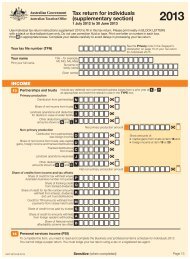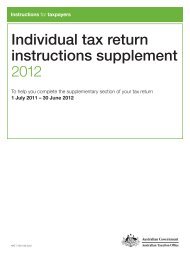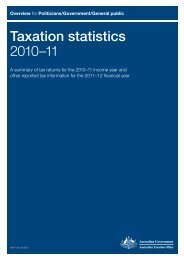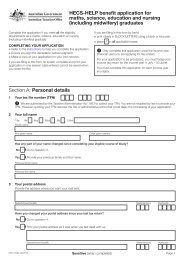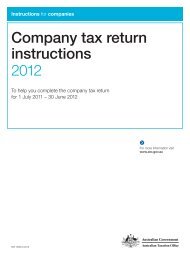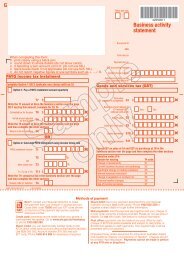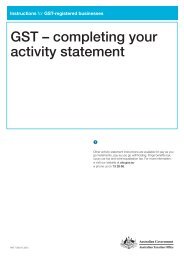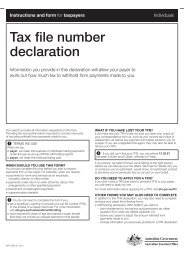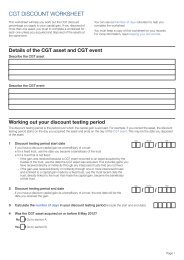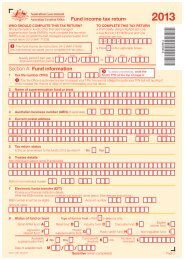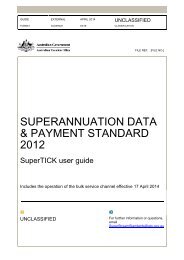Guide to depreciating assets 2013 - Australian Taxation Office
Guide to depreciating assets 2013 - Australian Taxation Office
Guide to depreciating assets 2013 - Australian Taxation Office
You also want an ePaper? Increase the reach of your titles
YUMPU automatically turns print PDFs into web optimized ePapers that Google loves.
use it for a taxable purpose, you need <strong>to</strong> work out the asset’sdecline in value from its start time, including the years youused it for a private purpose. You can then work out yourdeductions for the decline in value of the asset for the yearsyou used it for a taxable purpose; see Decline in valueof a <strong>depreciating</strong> asset used for a non-taxable purposeon page 8.Methods of working out decline in valueYou generally have the choice of two methods <strong>to</strong> work out thedecline in value of a <strong>depreciating</strong> asset: the prime cost methodor the diminishing value method. You can generally choose <strong>to</strong>use either method for each <strong>depreciating</strong> asset you hold.Once you have chosen a method for a particular asset,you cannot change <strong>to</strong> the other method for that asset.The Decline in value calcula<strong>to</strong>r at a<strong>to</strong>.gov.au will help youwith the choice and the calculations.In some cases, you do not need <strong>to</strong> make the choicebecause you can claim an immediate deduction for the asset,for example, certain <strong>depreciating</strong> <strong>assets</strong> that cost $300 orless; see Immediate deduction (for certain non-business<strong>depreciating</strong> <strong>assets</strong> costing $300 or less) on page 9.In other cases, you do not have a choice of which methodyou use <strong>to</strong> work out the decline in value. These cases are:n if you acquire intangible <strong>depreciating</strong> <strong>assets</strong> such as inhousesoftware, certain items of intellectual property,spectrum licences, datacasting transmitter licences andtelecommunications site access rights, you must use theprime cost methodn if you acquire a <strong>depreciating</strong> asset from an associate whohas deducted or can deduct amounts for the decline invalue of the asset; see Depreciating asset acquired froman associate on page 9n if you acquire a <strong>depreciating</strong> asset but the user of the assetdoes not change or is an associate of the former user, forexample, under sale and leaseback arrangements; seeSale and leaseback arrangements on page 9n if there has been rollover relief; see Rollover reliefon page 21n if the asset has been allocated <strong>to</strong> a low-value pool orsoftware development pool, the decline in value is calculatedat a statu<strong>to</strong>ry rate; see Software development pools onpage 25, and Low-value pools on page 22.Both the diminishing value and prime cost methods are basedon a <strong>depreciating</strong> asset’s effective life. The rules for workingout an asset’s effective life are explained in Effective lifeon page 11.By working out the decline in value you determine theadjustable value of a <strong>depreciating</strong> asset. A <strong>depreciating</strong>asset’s adjustable value at a particular time is its cost(first and second elements) less any decline in value up<strong>to</strong> that time. See The cost of a <strong>depreciating</strong> asset onpage 14 for information on first and second elements of cost.Adjustable value is similar <strong>to</strong> the concept of undeducted costused in the former depreciation rules. The opening adjustablevalue of an asset for an income year is generally the same asits adjustable value at the end of the previous income year.You calculate the decline in value and adjustable value of a<strong>depreciating</strong> asset from the asset’s start time independentlyof your use of the <strong>depreciating</strong> asset for a taxable purpose.However, your deduction for the decline in value is reduced<strong>to</strong> the extent that your use of the asset is for a non-taxablepurpose; see Decline in value of a <strong>depreciating</strong> asset usedfor a non-taxable purpose on page 8. Your deduction mayalso be reduced if the <strong>depreciating</strong> asset is a leisure facility orboat even though the asset is used, or installed ready for use,for a taxable purpose; see Decline in value of leisure facilitieson page 8, and Decline in value of boats on page 8.The diminishing value methodThe diminishing value method assumes that the decline invalue each year is a constant proportion of the remainingvalue and produces a progressively smaller decline over time.For <strong>depreciating</strong> <strong>assets</strong> that you started <strong>to</strong> hold on or after10 May 2006 the formula for the decline in value is:basevalue5*can be 366 in a leap yeardays held*200%3655asset’s effective lifewhere the base value for the income year in which an asset’sstart time occurs is the asset’s cost. For a later income year,the base value is the asset’s opening adjustable value forthat year plus any amounts included in the asset’s secondelement of cost for that year.Generally, you can use this formula <strong>to</strong> work out the declinein value of an eligible <strong>depreciating</strong> asset if you started <strong>to</strong> holdit on or after 10 May 2006. However, this formula may notapply in some cases, for example, if you held an asset before10 May 2006 but then disposed of it and reacquired it on orafter 10 May 2006 just so that you could use this formula <strong>to</strong>work out the asset’s decline in value.For <strong>depreciating</strong> <strong>assets</strong> you started <strong>to</strong> hold prior <strong>to</strong>10 May 2006 the formula for the decline in value is:basevalue5*can be 366 in a leap yeardays held*150%3655asset’s effective lifeEXAMPLE: Base value, ignoring any GST impactLeo purchased a computer for $6,000. The computer’sbase value in its start year would be its cost of $6,000.If the computer’s decline in value for that year is $1,500and no amounts are included in the second element ofthe computer’s cost, its base value for the next incomeyear would be its opening adjustable value of $4,500.This amount is the cost of the computer of $6,000 lessits decline in value of $1,500.‘Days held’ is the number of days you held the asset in theincome year in which you used it or had it installed ready foruse for any purpose. If the income year is the one in whichthe asset’s start time occurs, you work out the days heldfrom its start time. If a balancing adjustment event occursfor the asset during the income year (for example, if you sellit), you work out the days held up until the day the balancingadjustment event occurred; see What happens if you nolonger hold or use a <strong>depreciating</strong> asset? on page 17 forinformation about balancing adjustment events.6 a<strong>to</strong>.gov.au GUIDE TO DEPRECIATING ASSETS <strong>2013</strong>



